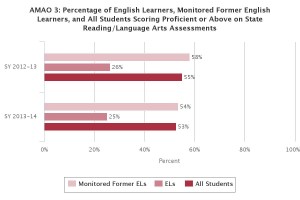Recently an educator approached me with concerns that several ELs were intentionally underperforming on assessments as a way to remain in the EL program. The teacher reported that student scores were consistently hovering just under the exit criteria.
I can relate to this educator’s frustration. This is a phenomenon I encounter in my own classroom during assessments, and I continually fight an internal battle with myself in an effort to refrain from seeing student scores as “intentional under-performance.” Why is it that our first impulse is to look to the student rather than consider what else we can do as teachers?
Most everyone’s heard the prevailing wisdom that “lower is faster, higher is slower” to explain the plateaus students experience when developing language proficiency. I try to seek understanding in this first, but like the educator who approached me for advice there have also been times when I’ve wondered just how long it’s going to take to move a higher proficiency student over that last little bump.
I asked several colleagues how they’ve approached this phenomenon, but garnered little that offered much direction. At long last I’ve located a very readable and realistic paper that offers practical suggestions for “high proficiency ELs” by Faridah Pawan and Anita Seralathan. Aptly titled “Moving on Up with WIDA: Helping Near-Proficient English Learners Reach Full Proficiency “ you can find a down-loadable version on page 29 of the Indiana Teachers of English to Speakers of Other Languages (INTESOL) Journal, Summer 2015.
In user-friendly terms, Pawan and Seralathan identify the lack of research that focuses on “high proficiency ELs”, and use case study examples from teachers in the field to offer evidence and resources that enable students “to also identify their own abilities and areas where help is needed” (p 38).
Another over-looked area when correlating academic content and language development is the cultural component. Language skill may seemed to have plateaued, but we often fail to consider that this may actually be the result of a lack of cultural competency related to the academic content. Pawan and Seralathan offer an example by quoting the experience an EL teacher shared of her students “reading Dante’s Inferno or the Scarlet Letter with little to no understanding of Christianity or the bible…while your language might be up to the task, it is untranslatable to you.” (p 40)
Pawan and Seralathan have generously sprinkled suggestions for using resources like WebQuest and Linguafolio throughout the paper, and offer examples of rubrics for scaffolding based on linguistics, conceptual, and social-cultural development.
Finally, Pawan and Seralathan cite examples of collaborative approaches taken by content and EL teachers to address the needs of “high proficiency ELs.”
I’d like to know of your experiences with students who hover at the upper end of the proficiency scale. What have you discovered? And what have you found useful in enabling students to move beyond the plateaus indicated on assessment measures?
